Terry L. Ettinger Horticulture Consulting Services
Meeting The Needs Of Today With A Vision For The Future
Recommended Shrubs -
`Endless Summer' Hydrangea
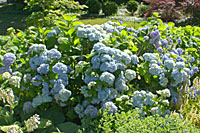 One of the most frequent questions I'm asked goes something like, "why doesn't my pink/blue hydrangea flower like those
I see out on Cape Cod, down on Long Island, in Philadelphia, etc.?"
One of the most frequent questions I'm asked goes something like, "why doesn't my pink/blue hydrangea flower like those
I see out on Cape Cod, down on Long Island, in Philadelphia, etc.?"
In a nutshell, the answer is that while these "bigleaf" hydrangea
plants are perfectly hardy to temperatures
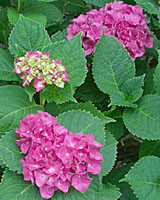 far below zero, their
flower buds, which form at the tips of their stems as the days get
shorter and cooler in the fall, are often killed
when temperatures drop to near 0°F. This is especially true in
winters featuring a stretch of relatively mild weather followed by a rapid plunge in
temperature to zero, or below!
far below zero, their
flower buds, which form at the tips of their stems as the days get
shorter and cooler in the fall, are often killed
when temperatures drop to near 0°F. This is especially true in
winters featuring a stretch of relatively mild weather followed by a rapid plunge in
temperature to zero, or below!
This frustrating trait of bigleaf hydrangeas (Hydrangea macrophylla) has been the bane of gardeners in northern states since the plant was introduced to North America in the 1800's.
 The beginning to the end of this frustration, however, started in a garden in the St.
Paul, Minnesota suburb of Cottage Grove where, in the mid-1980's, a
bigleaf hydrangea having the ability to form flower buds on new
shoots, white arrows in picture at right, was discovered by a sharp-eyed propagator from Bailey
Nurseries.
The beginning to the end of this frustration, however, started in a garden in the St.
Paul, Minnesota suburb of Cottage Grove where, in the mid-1980's, a
bigleaf hydrangea having the ability to form flower buds on new
shoots, white arrows in picture at right, was discovered by a sharp-eyed propagator from Bailey
Nurseries.
Fast-forward to 2003, Bailey Nurseries introduced this unique hydrangea it had named and patented as `Endless Summer.' A year later, the nursery sold 1.5 million of these hydrangeas across North America!
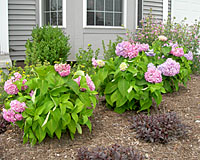 Intrigued by the possibility of recommending a reliable-blooming bigleaf hydrangea to Central New York
gardeners, I incorporated several `Endless Summer' into landscape designs I was preparing for clients.
Intrigued by the possibility of recommending a reliable-blooming bigleaf hydrangea to Central New York
gardeners, I incorporated several `Endless Summer' into landscape designs I was preparing for clients.
Exactly as promoted, these plants have thrived and bloomed well in these gardens during the past several summers, and I'm confident they'll continue do so for many years to come.
If you'd like to enjoy the pink (alkaline soil) or blue (acid soil) flowers of bigleaf hydrangea in your garden, plant the three to five foot tall and wide `Endless Summer' in a spot where the soils are well-drained, yet moisture-retentive. And, while `Endless Summer' will produce a few small flowers when it receives as little as two or three hours of sun each day, it flowers best when planted in full sun but protected from harsh winds.
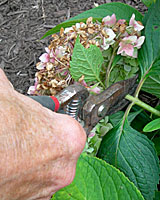 To
avoid pruning off new flower buds forming at the tips of stems in
late summer, clip off spent blooms at a point just above the first
set of leaves beneath the bloom. And, in the spring, do not cut
"dead" stems to the ground until new leaves have completely expanded
- often not until early June.
To
avoid pruning off new flower buds forming at the tips of stems in
late summer, clip off spent blooms at a point just above the first
set of leaves beneath the bloom. And, in the spring, do not cut
"dead" stems to the ground until new leaves have completely expanded
- often not until early June.
Finally, don't be alarmed if the leaves of your `Endless Summer'
become covered with purplish-edged spots in mid- to late July
through the end of the season, below left. The spots are caused by a
very common disease that infects young leaves as they're
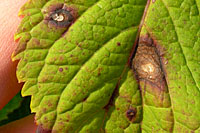 expanding
during wet weather in early spring. The disease is harmless and may
not occur in years when spring weather is on the dry side.
expanding
during wet weather in early spring. The disease is harmless and may
not occur in years when spring weather is on the dry side.